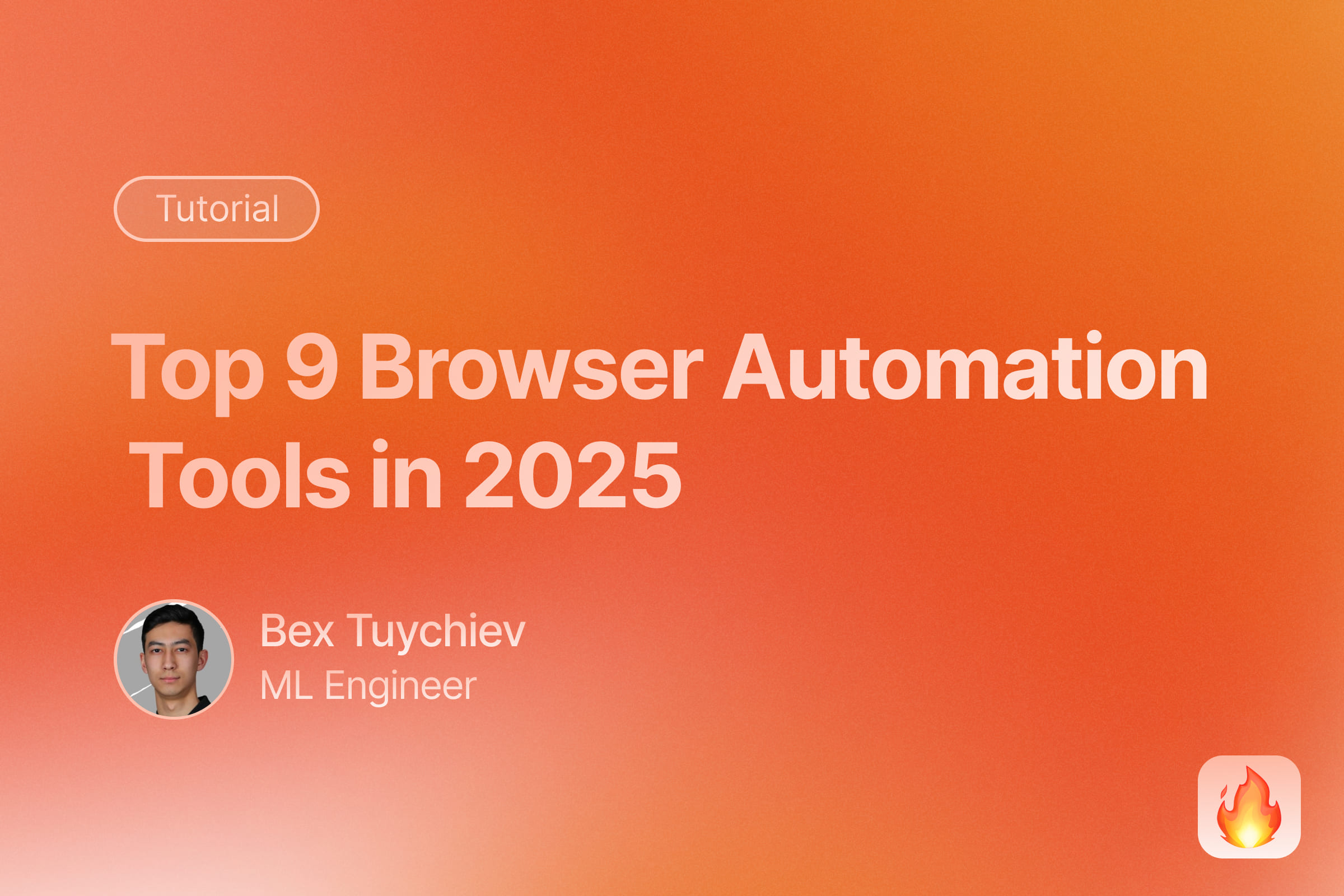
Introduction
As I’ve been dabbling in the quickly changing landscape of web development in the last few years, I have seen browser automation tools change from a developer-only tool to an important part of modern tech stacks. It is now 2025, and these tools have become necessary if a business wants to improve testing processes, collect and analyze more data, and overall automate web-based repetitive tasks efficiently. The market has been responsive and adoption has evolved in almost every industry, and many new and exciting solutions have emerged, taking advantage of AI, the cloud, and headless workflows.
In this guide, we will look at some of the strongest browser automation tools on the market today, reviewing the features and practical use case of each. If you are less technical and are simply looking for more efficient ways to collect web data, or if you are a developer looking for the best way to optimize your test scenario, or even if you are a product manager looking at the potential for automation in your technology stack, you will find useful and actionable insights for thinking through the right tool for your use case and implementing it into your organization.
Types of Browser Automation Tools
Before diving into specific automation solutions, understanding the distinct categories of browser automation tools will save countless hours of trial and error. Across many projects, I’ve found that matching the right tool category to your specific needs is often more important than choosing between individual products within the same category.
Headless browser solutions like Puppeteer and Playwright operate without a visible user interface, making them ideal for server environments and CI/CD pipelines where resource efficiency is crucial. These tools excel at running tests, generating screenshots, and performing automated tasks with minimal overhead. My first large-scale automation project relied heavily on headless browsers, and the performance gains compared to full browser solutions were immediately apparent in our production environment.
Full browser automation frameworks provide comprehensive control over visible browsers, enabling developers to simulate complex user interactions across multiple tabs and windows. Tools in this category, such as Selenium WebDriver and Cypress, support diverse testing scenarios from unit tests to end-to-end validation. Their extensive programming interfaces accommodate everything from simple click sequences to sophisticated multi-step workflows that mirror real user behavior.
The landscape also includes specialized solutions focused on specific use cases. Web scraping and data extraction tools like Firecrawl and Scrapy are optimized for gathering information from websites at scale, with built-in features for handling pagination, authentication, and anti-bot measures. Meanwhile, the emergence of no-code/low-code automation platforms has democratized browser automation, allowing business users without programming expertise to create custom workflows through intuitive drag-and-drop interfaces and visual editors.
Top Browser Automation Tools Reviewed
Now that we have looked at browser automation tool categories, it’s time to share our thoughts on the best tools available in 2025. Each of the tools listed below has been evaluated in terms of the technical functionality, the learning curve, the community support, and the use case or area that it serves best. Whether you are looking for a complex testing framework on an enterprise scale or a simpler tool for data extraction - this analysis will help you identify the best browser automation tool for your needs.
Firecrawl: Turn Websites into LLM-Ready Data
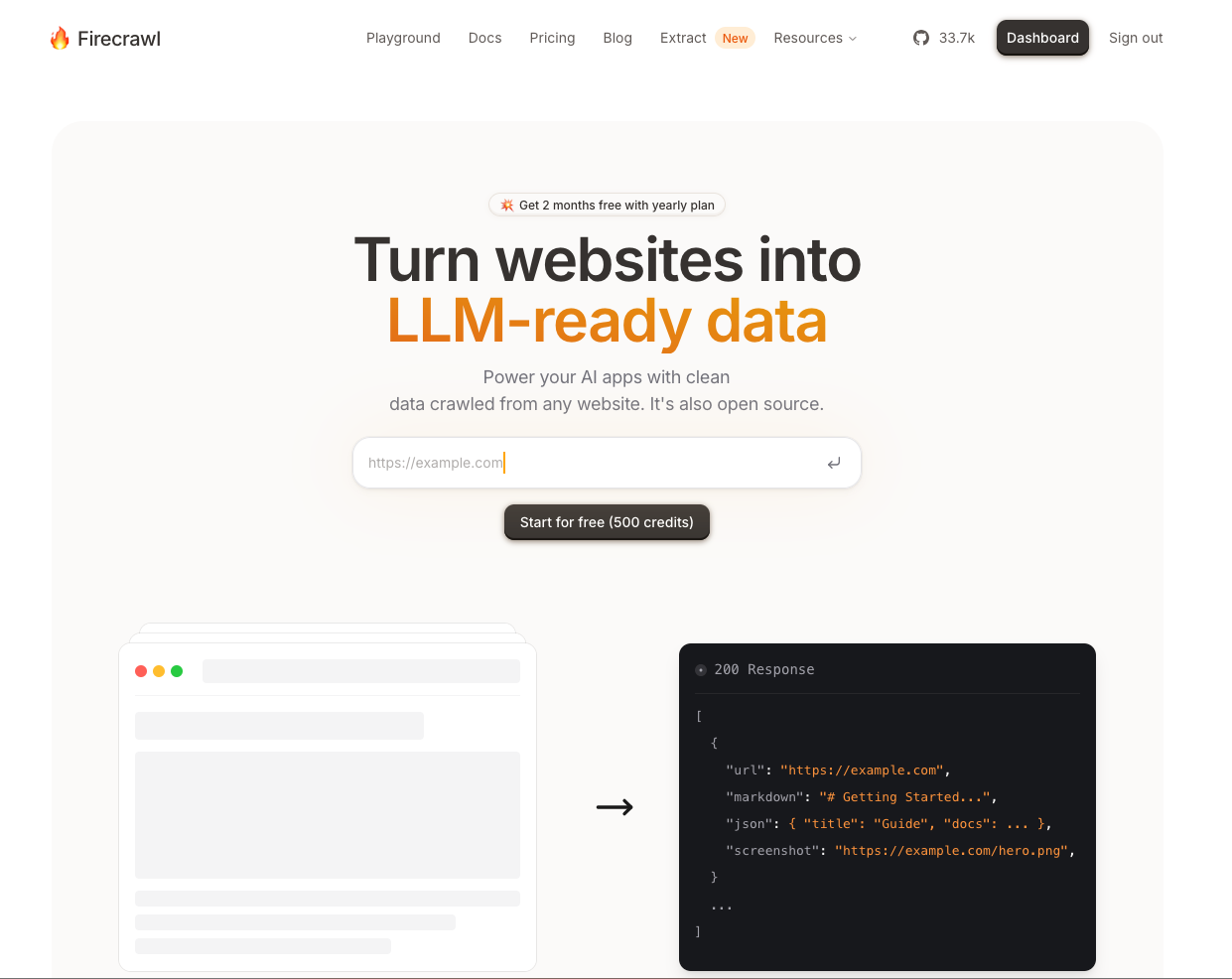
Firecrawl stands out as a powerful platform specifically designed to scrape websites and convert their content into clean, structured data formats like Markdown and JSON, making it ideal for AI and LLM applications. It handles the complexities of modern web scraping, including dynamic content and JavaScript-heavy sites, with minimal configuration.
Key Highlights:
- AI & LLM Focused: Excels at preparing web data for AI model training and RAG pipelines. Features like the
/extractendpoint allow data extraction using natural language prompts, and the/llmstxtAPI generates LLM-ready text files directly from websites. - Effortless Crawling & Scraping: Reliably crawls entire websites (even without sitemaps) and scrapes individual pages, automatically handling challenges like dynamic content loading and rotating proxies. Outputs clean Markdown, JSON, or HTML.
- Developer Friendly: Offers official SDKs for Python, Node.js, Go, and Rust, alongside a REST API and integrations with popular frameworks like LangChain and LlamaIndex.
- Flexible Access: Provides a generous free tier to get started, scalable paid plans based on usage credits, and an open-source version (AGPL-3.0) for self-hosting.
Good to Know:
- Best suited for publicly accessible web content.
- API rate limits and feature access vary depending on the chosen plan.
- Pricing: Starts with a 500-credit free tier; paid plans begin around $16/month. View details.
- Advanced features like Extract have specific pricing models.
Selenium: The Industry Standard for Browser Automation
As one of the oldest and most established players in the browser automation space, Selenium has long been considered the de facto standard for web testing and automation tasks. Its comprehensive suite of tools and robust community support make it a foundational technology for countless development and QA teams worldwide.
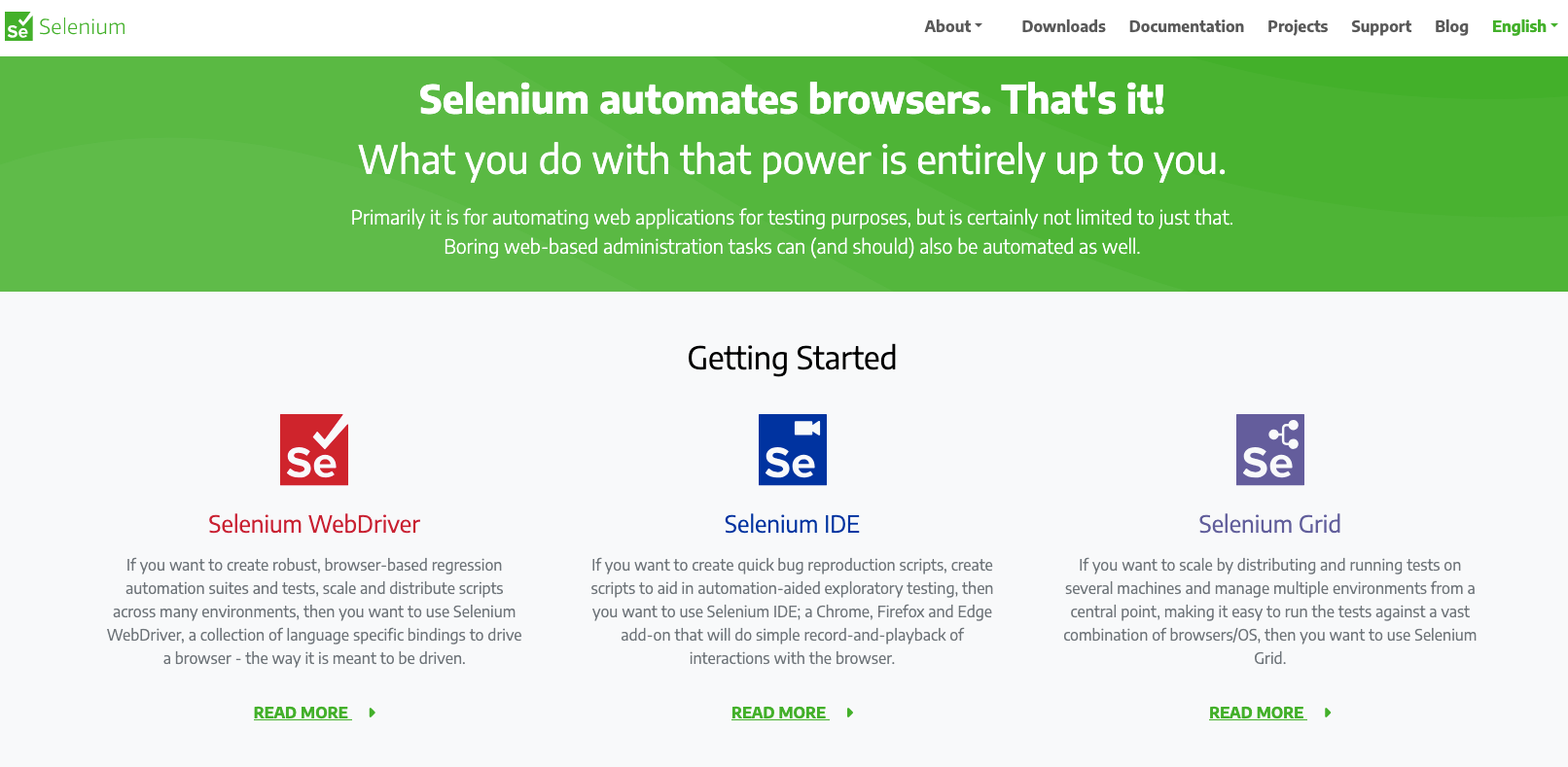
Key Highlights:
- Industry Standard: Widely recognized and utilized for web browser automation, particularly for testing web applications. It has a large, established community and extensive documentation.
- Language & Browser Flexibility: Supports a wide range of programming languages including Java, Python, C#, Ruby, JavaScript, and more. Compatible with major browsers like Chrome, Firefox, Edge, Safari, and Internet Explorer.
- Component Suite: Offers different tools for various needs:
- Selenium WebDriver: Provides APIs for browser control and creating robust regression tests.
- Selenium IDE: A browser extension (Chrome, Firefox, Edge) for simple record-and-playback test script creation.
- Selenium Grid: Enables running tests in parallel across multiple machines, browsers, and operating systems for scaling test execution.
- Extensible Ecosystem: Easily integrates with popular testing frameworks (like JUnit, TestNG), reporting tools (like Allure, ExtentReports), and CI/CD pipelines (like Jenkins, GitLab).
Good to Know:
- Open Source & Free: Selenium is an open-source project available under the Apache 2.0 license, making it completely free to use.
- Web-Focused: Designed specifically for automating web browsers; requires integration with other tools like Appium for native mobile or desktop application testing.
- Requires Technical Skill: Setting up and writing effective Selenium tests requires programming knowledge and understanding of browser drivers and testing frameworks. The setup can be complex compared to some all-in-one solutions.
- Learning Curve: Can have a steeper learning curve for beginners compared to newer frameworks or record-and-playback tools.
- Relies on Integrations: Lacks built-in advanced reporting, debugging, or test management features, relying instead on integration with third-party tools.
- Performance: Running large test suites efficiently often requires using Selenium Grid for parallel execution, which adds setup and maintenance overhead.
Pricing: Free and open-source (Apache 2.0 License).
Puppeteer: Headless Chrome & Firefox Automation Made Simple
Developed by Google, Puppeteer is a powerful Node.js library providing a high-level API to control Chrome or Firefox over the DevTools Protocol or WebDriver BiDi. It’s renowned for its efficiency in headless browser automation, making it a favorite for tasks like web scraping, automated testing, and server-side rendering.
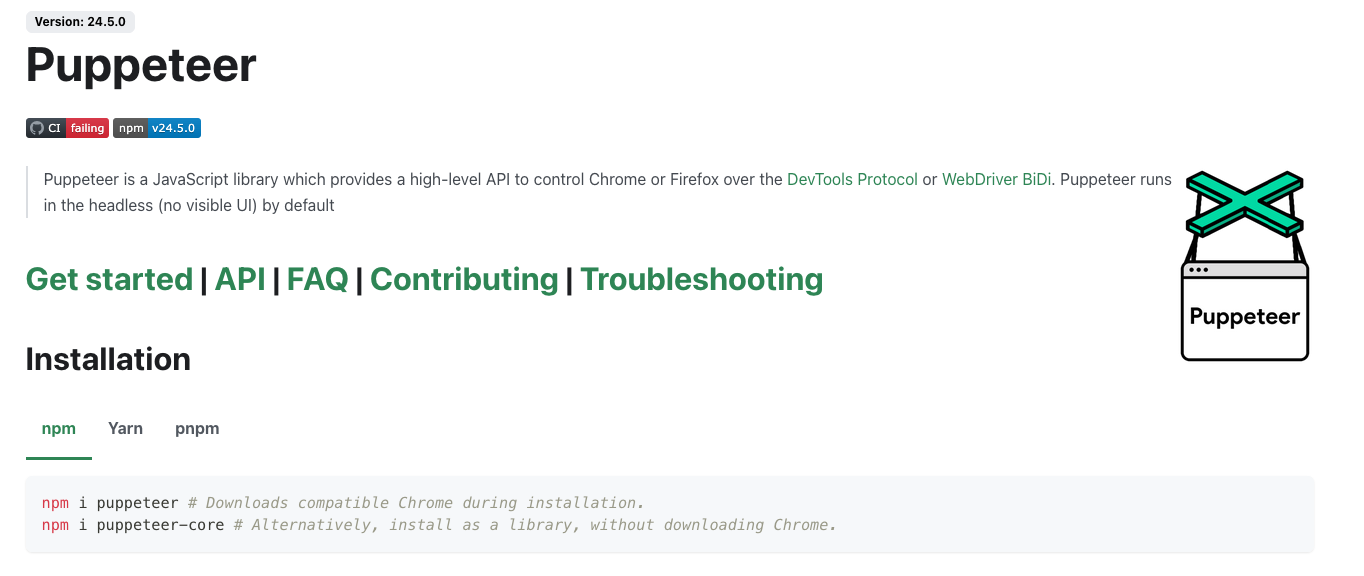
Key Highlights:
- Node.js Focused: Primarily designed as a JavaScript library for Node.js environments.
- Headless First: Runs headless by default for optimal performance in server environments, but can be configured to run “headful” (visible browser).
- Chrome & Firefox Control: Offers robust control over Chromium-based browsers and Firefox. (Source, Source)
- High-Level API: Provides a clean and intuitive API for common browser actions like navigation, form submission, UI interaction, taking screenshots, generating PDFs, and more. (Source)
- Versatile Use Cases: Ideal for automated testing (especially unit/integration tests), web scraping, generating pre-rendered content for SPAs (SSR), capturing performance timelines, and automating browser tasks. (Source)
- Browser Management: The standard
puppeteerpackage automatically downloads a compatible browser version, whilepuppeteer-coreallows using an existing browser installation. (Source)
Good to Know:
- JavaScript Prerequisite: Requires familiarity with JavaScript and Node.js.
- Primarily Chrome/Firefox: While Firefox support is available, it historically focused on Chrome/Chromium, which remains its most mature target.
- API-Driven: Focuses on providing a control library; test runner integration (like Jest, Mocha) is typically handled separately by the user.
- Performance: Headless operation generally offers better performance and lower resource usage compared to full browser automation.
Pricing: Free and open-source (Apache 2.0 License).
Cypress: End-to-End Testing for Modern Web Applications
Cypress is a JavaScript-based end-to-end testing framework designed specifically for modern web applications. It aims to provide a superior developer experience by making setting up, writing, running, and debugging tests faster and easier. (Source)

Key Highlights:
- Developer-Centric Experience: Focused on ease of use, fast setup (no drivers/servers needed), real-time reloads as you code, and interactive visual debugging directly within the browser’s DevTools. (Source)
- All-in-One Testing Framework: Provides a complete testing solution including the test runner, assertion library, mocking/stubbing capabilities, and support for both end-to-end and component testing. (Source)
- Visual Debugging & Time Travel: Offers features like DOM snapshots for each step, allowing you to visually inspect the application’s state, network requests, and console output as they happened during the test run.
- Flake Resistance: Designed with features like automatic waiting for commands and assertions to reduce test flakiness compared to traditional frameworks. (Source)
- Cypress Cloud: A companion paid service that enhances CI workflows with features like smart orchestration (parallelization, load balancing), visual test reviews, test analytics, and integrations with tools like Slack, GitHub, and Jira. (Source)
- New Features: Continuously evolving with features like UI Coverage tracking and integrated Accessibility checks. (Source)
Good to Know:
- JavaScript/TypeScript Based: Tests are written exclusively in JavaScript or TypeScript.
- Testing Focus: Primarily built for testing web applications (both E2E and component level), less suited for general web scraping or browser automation tasks compared to tools like Puppeteer or Playwright.
- Architecture: Runs in the same run loop as the application being tested, providing direct access and potentially faster execution but with some architectural differences from WebDriver-based tools.
- Cross-Browser Support: Supports Chrome, Firefox, Edge, and Electron, though historically Chrome support has been the most mature.
Pricing:
- Cypress App (Test Runner): Free and open-source (MIT License).
- Cypress Cloud: Offers various paid tiers (starting with a free plan) based on the number of test results, parallelization needs, and advanced features like visual reviews and analytics. (Source)
Playwright: Cross-Browser Automation for the Modern Web
Developed by Microsoft, Playwright is a modern, capable framework designed for reliable end-to-end testing and automation across all major rendering engines. It offers a single API to automate Chromium, Firefox, and WebKit, making true cross-browser testing a primary focus. (Source)
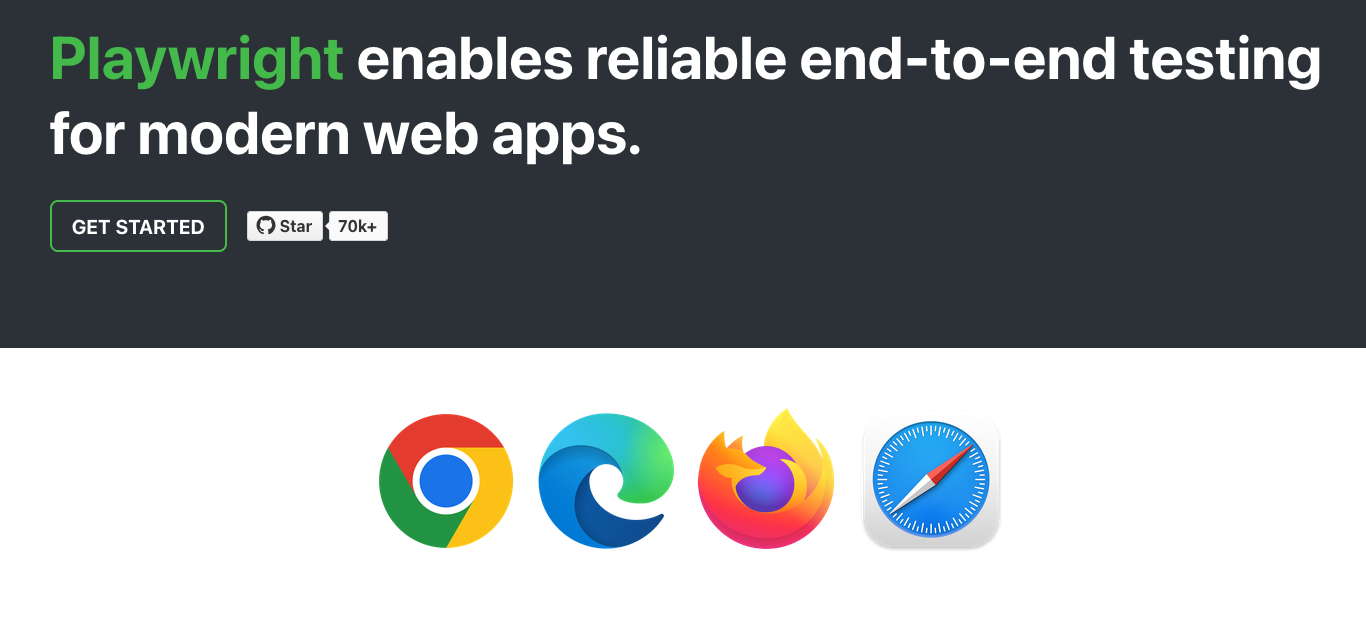
Key Highlights:
- True Cross-Browser: Supports Chromium (Chrome, Edge), Firefox, and WebKit (Safari) with a single API across Windows, Linux, and macOS.
- Multi-Language Support: Provides official SDKs for TypeScript, JavaScript, Python, .NET, and Java.
- Resilient Automation: Features auto-waits, web-first assertions that automatically retry, and tracing capabilities (screenshots, video, DOM snapshots via Trace Viewer) to combat test flakiness.
- Test Isolation & Speed: Uses browser contexts (like incognito profiles) for full test isolation with minimal performance overhead. Supports saving authentication states to speed up tests.
- Handles Complex Scenarios: Built to manage tests involving multiple tabs, origins, frames, and user sessions. Uses a real browser input pipeline for trusted events and can pierce Shadow DOM.
- Mobile Web Emulation: Includes built-in emulation for Mobile Safari and Chrome for Android.
- Powerful Tooling: Comes with Codegen (record actions to generate tests), Playwright Inspector (step through tests, explore selectors), and Trace Viewer (detailed failure analysis).
Good to Know:
- Versatile: While excellent for E2E testing, its robust API also makes it suitable for web scraping and general browser automation.
- Architecture: Runs tests out-of-process, aligning with modern browser architecture and avoiding limitations of in-process runners.
- Growing Ecosystem: Rapidly gaining popularity and features, often seen as a strong alternative to Selenium and Cypress.
Pricing: Free and open-source (Apache 2.0 License).
Testim: AI-Powered Test Automation for Resilient Testing
Testim is a commercial test automation platform that leverages AI to accelerate the authoring, execution, and maintenance of tests for web, mobile, and Salesforce applications. Its primary focus is on improving test stability and reducing maintenance overhead through AI-powered locators and features. (Source, Source)
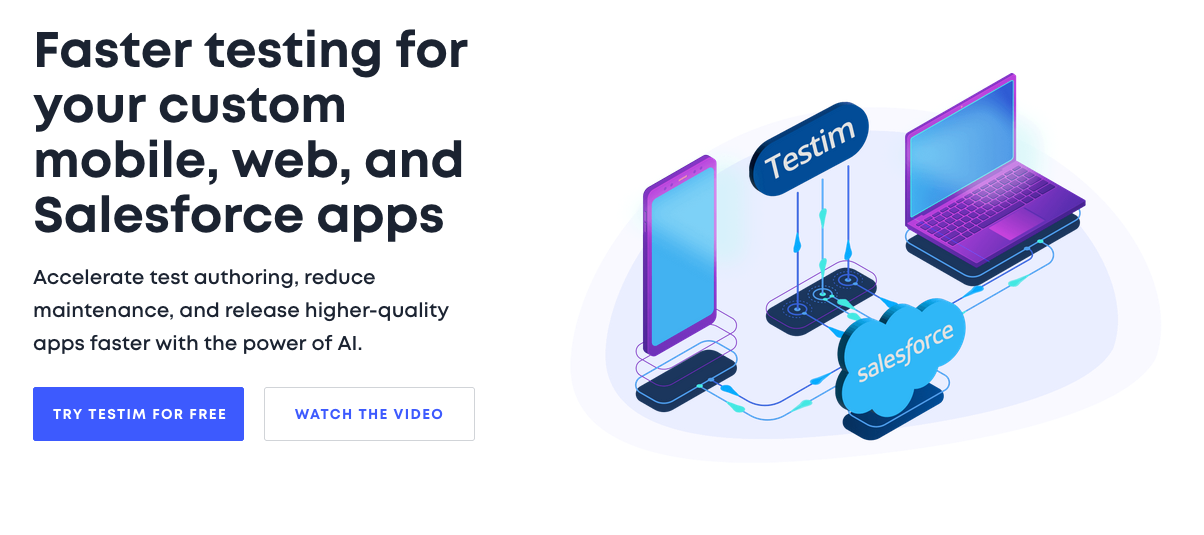
Key Highlights:
- AI-Driven Stability: Uses “Smart Locators” powered by AI to identify elements reliably and automatically adapt to changes in the application UI, significantly reducing test maintenance. (Source)
- Low-Code Authoring: Features a recorder-based interface for quickly creating tests, while still allowing custom JavaScript code for complex logic or validations.
- Broad Application Support: Offers tailored solutions for testing custom web applications, native/hybrid mobile apps (iOS & Android, including Flutter/React Native support), and specialized testing for Salesforce environments. (Source)
- TestOps & Troubleshooting: Provides features for test management, scaling (TestOps), detailed root cause analysis with screenshots and logs, and integrations with CI/CD pipelines and test management tools like Jira. (Source)
- Cloud-Based Execution: Runs tests in parallel on their cloud grid, third-party grids (Selenium/Appium compatible), or locally. Mobile testing supports cloud devices (virtual and real) and local devices.
- Testim Copilot: An integrated generative AI assistant to help create, document, and debug tests using natural language prompts. (Source)
Good to Know:
- Commercial SaaS Platform: Testim is primarily a paid service with different plans for web, mobile, and Salesforce testing.
- Testing Focus: Designed as an end-to-end testing platform, not primarily for web scraping or general automation.
- AI Dependency: Core stability features rely heavily on their proprietary AI algorithms.
- Vendor Lock-in: While tests can potentially be exported to formats like Playwright/Selenium, this might require modifications and is typically available on higher plans. (Source)
Pricing:
- Commercial Plans: Requires contacting sales for customized pricing based on needs (parallel tests, specific features for Web, Mobile, Salesforce). (Source)
- Free Community Plan: A limited free plan is available after the trial expires, offering serialized web runs and self-service support. (Source)
Browserflow: No-Code Web Automation for Everyone
Browserflow is a no-code/low-code Chrome extension designed to automate repetitive tasks and scrape websites directly within the browser. It focuses on empowering users without coding skills to build custom automations (“flows”) quickly through a visual interface. (Source, Source)
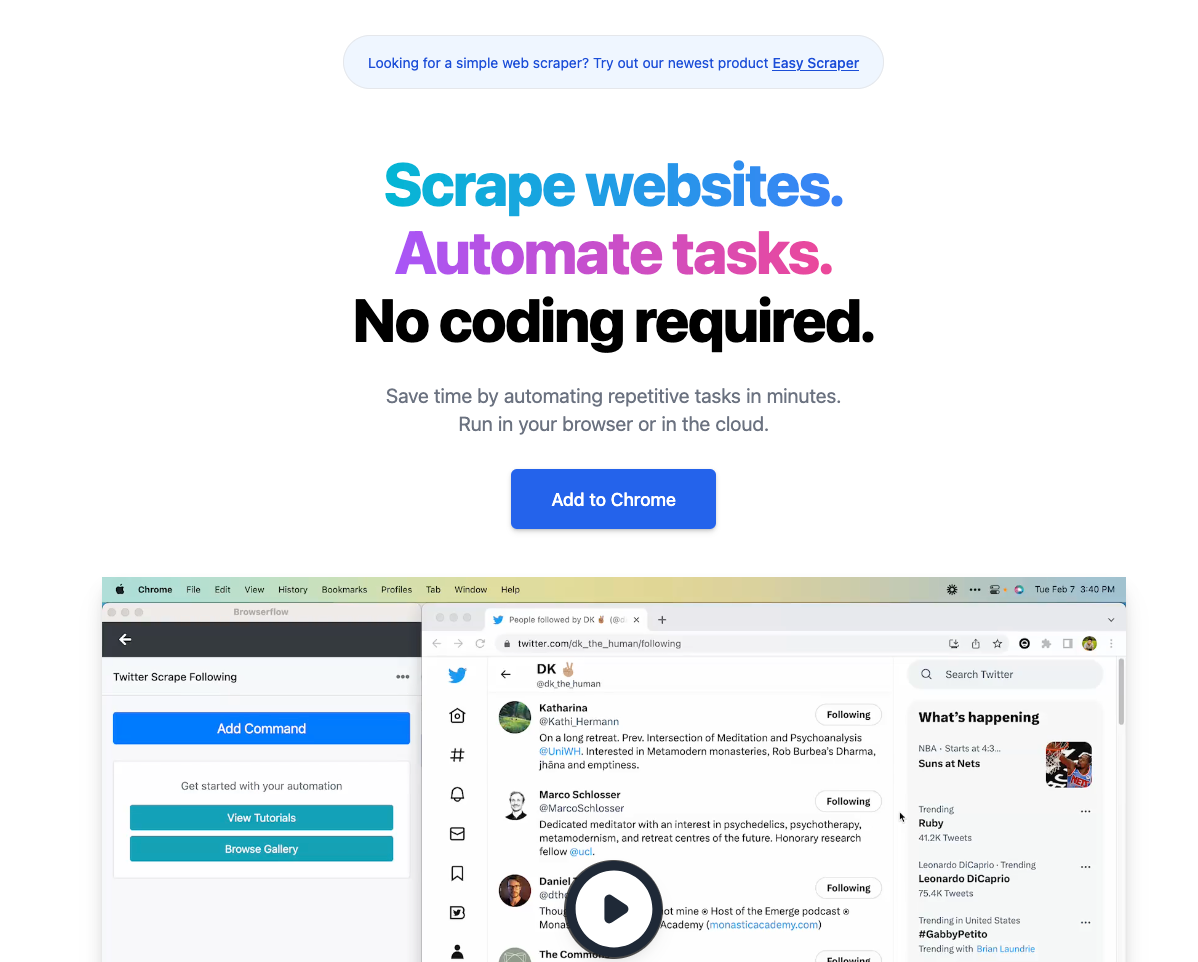
Key Highlights:
- No-Code/Low-Code Focus: Build automations using a visual editor with built-in commands for clicking, typing, extracting data, looping, and more. Includes a recorder to automatically generate flows based on user actions. (Source)
- Chrome Extension: Operates primarily as a Chrome extension, running automations locally within the user’s browser environment.
- Scraping & Task Automation: Excels at extracting data from websites (including handling pagination/infinite scroll) and automating multi-step tasks like form filling or data entry.
- Cloud Execution: Offers optional cloud infrastructure to run flows on a schedule (up to every minute on higher plans), even when the user’s computer is off. Cloud plans include features like API/webhook access and proxy usage. (Source)
- Google Sheets Integration: Built-in capability to read data from and write data to Google Sheets.
- Customizable: Allows running custom JavaScript for more complex logic or interactions beyond the built-in commands.
- Community Gallery: Provides ready-made flows for common tasks that users can adapt or reuse.
Good to Know:
- Requires Chrome: As a Chrome extension, it necessitates using Google Chrome.
- Local vs. Cloud: Core automation runs locally via the extension; scheduled and advanced features (proxies, API) require cloud plans.
- Focus: Primarily aimed at personal productivity, data scraping, and automating workflows rather than complex software testing scenarios.
- Limits: Free and lower-tier plans have limitations on execution time per run, number of cloud flows, and run frequency. (Source)
Pricing:
- Freemium Model: Offers a free tier with limitations on local run time (1 min) and cloud features (30 mins/month, 1 flow, daily frequency).
- Paid Tiers: Starter, Professional, and Business plans offer increased execution time, more cloud flows, higher frequency scheduling, proxies, API/webhook access, and priority support. Plans start at $19/month (billed yearly). (Source)
Axiom AI: Business Process Automation at Scale
Axiom is a no-code browser automation tool, primarily delivered as a Chrome Extension, designed for automating website actions, data scraping, and repetitive tasks directly in the browser. It allows users to build custom browser bots without code to handle workflows like data entry and UI interaction. (Source)

Key Highlights:
- No-Code Focus: Build automations (“bots”) using a visual interface with steps for clicking, typing, scraping, loops, conditional logic, etc. (Source)
- Chrome Extension: Installs and runs primarily within the Chrome browser, processing data locally.
- Web Scraping & Data Entry: Strong focus on extracting data from websites (including visually selecting elements) and automating data input into forms or spreadsheets. (Source)
- Integrations: Connects with Google Sheets, ChatGPT, Zapier, Make, webhooks, and provides an API for more complex integrations. (Source)
- Scheduling & Triggers: Bots can be run manually, on a schedule, or triggered via external systems like Zapier or webhooks.
- Advanced Features: Supports handling logins, solving CAPTCHAs (via integration), running custom JavaScript, and using proxies for some operations.
- Templates: Offers pre-built templates for common automation tasks.
Good to Know:
- Requires Chrome: Operates as a Chrome extension.
- Local Processing: Bots generally run and process data within your local browser, though scheduling implies cloud components. Axiom states they don’t store the results of your automations. (Source)
- Workflow Automation Focus: Primarily aimed at business process automation, data scraping, and task automation rather than formal software testing.
- Runtime Limits: Plans are often based on runtime (the amount of time bots spend executing).
Pricing:
- Free Tier: Offers a free starting plan with 2 hours of runtime. (Source)
- Paid Plans: Various paid tiers are available offering more runtime, advanced features, and support. Specific details require visiting their website or contacting sales.
Bardeen AI: AI Automation for Everyday Workflows
Bardeen is an AI-powered workflow automation platform, primarily operating as a Chrome extension, designed to streamline tasks, particularly for Go-To-Market (GTM) teams like Sales, Customer Success, and Revenue Operations. It focuses on integrating various web applications and using AI to automate repetitive workflows directly in the browser. (Source)
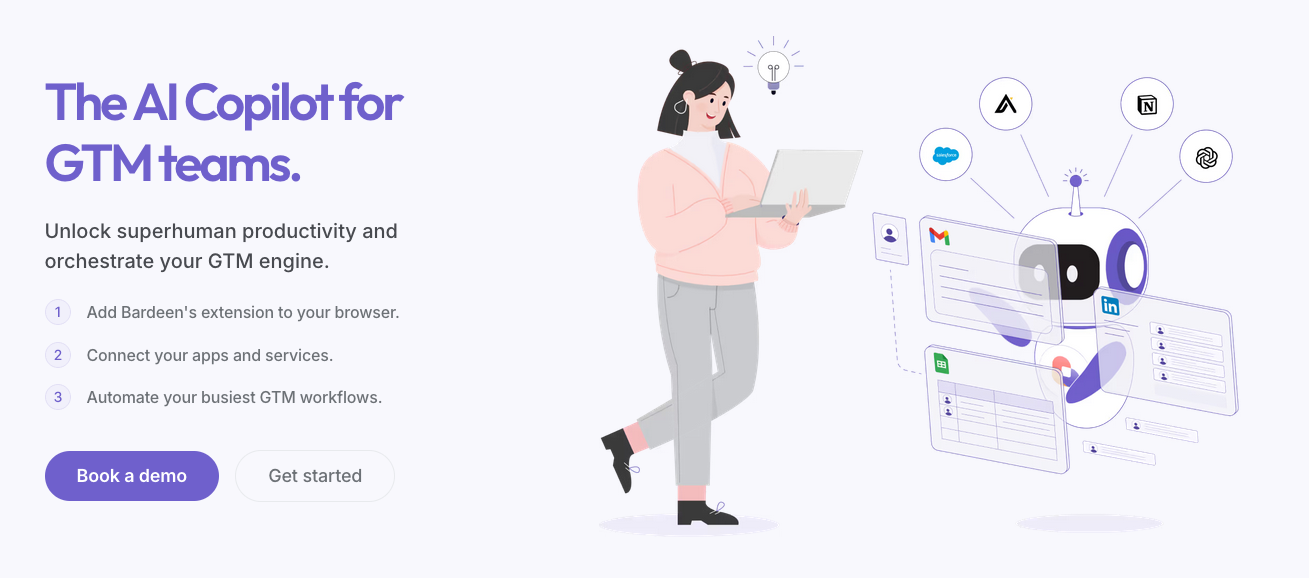
Key Highlights:
- AI-Driven GTM Automation: Pitched as an “AI Copilot for GTM teams,” it automates tasks like lead sourcing, CRM enrichment, account management updates, competitive intelligence gathering, and reporting. (Source)
- No-Code & Natural Language: Offers a visual no-code builder alongside “Magic Box” for creating automations using everyday language prompts.
- Chrome Extension: Runs within the Chrome browser, allowing interaction with websites and web apps.
- Extensive Integrations: Connects with a wide range of sales tools (HubSpot, Salesforce, Apollo, Salesloft), work apps (Google Sheets, Notion, Slack), and AI services (OpenAI). (Source)
- AI Features: Includes AI web scraping, AI message generation, and AI agents for more complex tasks.
- Playbook Templates: Provides ready-to-use automation templates for common GTM tasks.
- AIgency Support: Offers a blend of AI and human expertise to help build custom automations on higher tiers. (Source)
Good to Know:
- Requires Chrome: Operates as a Chrome extension.
- GTM Focus: Strongly oriented towards sales, marketing, and customer success workflows rather than general web testing or complex technical automation.
- Credit-Based Pricing: Usage is measured in credits consumed by automations, with different tiers offering varying credit amounts. (Source)
- Cloud Workflows: Scheduled automations running in the cloud are available on paid plans.
Pricing:
- Freemium Model: Offers a free plan with 100 credits/month.
- Paid Tiers (Starter, Teams, Enterprise): Provide significantly more credits, premium integrations (CRM, Outreach), cloud workflows, and access to AIgency support. Starter plan begins around $99/month (billed annually). (Source)
How to Choose the Right Browser Automation Tool From the List
Selecting the ideal tool from this diverse list requires aligning the tool’s strengths with your specific project needs, team capabilities, and budget. Start by clearly defining your primary goal. Are you focused on rigorous end-to-end testing of web applications? If so, established frameworks like Selenium, Cypress, Playwright, or the AI-enhanced Testim are likely your best starting points. For web scraping and data extraction, particularly if your goal is preparing clean, structured data ready for AI and LLM applications, Firecrawl is specifically engineered for this purpose, offering dedicated endpoints and formats. Puppeteer and Playwright are also strong general-purpose contenders, especially for headless operation. If your main aim is to automate repetitive personal or business workflows (Robotic Process Automation or RPA), the no-code/low-code platforms – Browserflow, Axiom AI, and Bardeen AI – provide intuitive visual builders.
Next, consider your team’s technical expertise. If coding isn’t feasible or desired, Browserflow, Axiom AI, Bardeen AI, and the low-code aspects of Testim are designed for accessibility. For teams comfortable with JavaScript/TypeScript, Puppeteer and Cypress offer powerful, focused environments. If your team uses languages like Python, Java, or C#, or you need broad language flexibility, Selenium and Playwright provide multi-language SDKs.
Browser compatibility is another crucial factor. For the widest reach across Chromium, Firefox, and WebKit, Playwright and Selenium (with the correct drivers) are top choices. Puppeteer targets Chromium and Firefox effectively. Many others, including the no-code tools and Cypress, primarily focus on Chrome or Electron, although Cypress has expanded its support.
Budget plays a significant role. Fully free and open-source options include Selenium, Puppeteer, Playwright, and the core Cypress App test runner. Most other tools operate on a freemium model, offering a usable free tier with paid plans unlocking more features, runtime, or support. This includes Firecrawl, Testim, Browserflow, Axiom AI, Bardeen AI, and the Cypress Cloud service. Testim leans more towards a commercial model for its advanced capabilities and enterprise scale.
Finally, evaluate any specific feature requirements. Do you need built-in AI capabilities? Tools like Testim focus on AI for test stability, while Firecrawl leverages it to transform scraped content into LLM-ready formats, and Bardeen AI uses it for GTM workflow intelligence. For mobile application testing (beyond web emulation), Testim offers dedicated solutions. If your workflows center around Salesforce or specific Go-To-Market processes, Testim and Bardeen AI, respectively, provide tailored features.
Comparison Summary
| Tool | Primary Use Case | Skill Level | Key Language(s) | Browser Engines | Licensing | Notable Strength |
|---|---|---|---|---|---|---|
| Firecrawl | Web Scraping (for AI/LLM) | Code (SDKs) | Multi | Chromium (Managed) | Freemium/Open (AGPL) | LLM-ready data extraction |
| Selenium | E2E Testing | Code | Multi | All (via Drivers) | Open Source (Apache) | Industry Standard, Ecosystem |
| Puppeteer | Headless Automation/Scraping | Code | JS/TS | Chromium, Firefox | Open Source (Apache) | Headless Efficiency, Chrome DevTools |
| Cypress | E2E & Component Testing | Code | JS/TS | Chromium, Firefox, etc. | Freemium/Open (MIT) | Developer Experience, All-in-One |
| Playwright | E2E Testing, Automation | Code | Multi | Chromium, Firefox, WebKit | Open Source (Apache) | Cross-Browser, Resilient Auto-Wait |
| Testim | E2E Testing (Web, Mobile) | Low-Code/Code | JS (Optional) | Chromium, Firefox, etc. | Freemium/Commercial | AI Stability, Salesforce/Mobile |
| Browserflow | Task Automation, Scraping | No-Code/Low-Code | JS (Optional) | Chrome | Freemium/Commercial | Simplicity, Extension-based |
| Axiom AI | Task Automation, Scraping | No-Code/Low-Code | JS (Optional) | Chrome | Freemium/Commercial | Visual Builder, Integrations |
| Bardeen AI | GTM Workflow Automation | No-Code/Low-Code | N/A | Chrome | Freemium/Commercial | AI GTM Focus, Integrations |
By considering these factors and referring to the table, you can narrow down the options and choose the browser automation tool that best fits your project’s requirements and constraints.
Future Trends
AI is rapidly transforming browser automation, creating systems that can develop tests, self-heal broken scripts, and analyze data autonomously. This intelligence advancement coincides with a growing emphasis on mobile automation, as testing strategies must now account for diverse user devices. Frameworks like Playwright and Appium are bridging the gap between web and mobile automation, creating unified solutions that work seamlessly across both interfaces.
The rise of low-code/no-code tools has empowered non-developers to create sophisticated workflows spanning multiple applications and data sources. However, this growth raises ethical concerns regarding data privacy, potential website performance impacts, and compliance with site policies. As regulations like GDPR evolve, the industry will need to balance performance optimization with responsible automation practices. These considerations will interact with technological advancements to shape the future of browser automation.
Conclusion
Choosing the right browser automation tool in 2025 requires careful consideration of your specific use case, technical requirements, and resource constraints. Throughout this guide, we’ve explored how different tools excel in distinct scenarios – from Selenium’s mature ecosystem and broad language support to Cypress’s developer-friendly testing approach and Playwright’s superior cross-browser capabilities. For organizations focused specifically on leveraging web data for AI and LLM applications – a rapidly growing need in 2025 – Firecrawl stands out with its targeted extraction and conversion capabilities, designed to transform websites into structured, analysis-ready data with minimal configuration. Its ability to handle complex JavaScript-heavy sites while providing clean output formats makes it particularly valuable for teams building the AI systems of tomorrow.
Next Steps
- Convert scraped data to llms.txt files for LLM training
- Use browser automation in agent frameworks for autonomous workflows
- Enhance data with RAG frameworks for AI applications
- Integrate with MCP servers for development workflows
As browser automation continues to evolve, the line between specialized tools will blur further, with AI-enhanced capabilities becoming standard across platforms. When implementing your automation strategy, remember that success depends less on the specific tool and more on following best practices – robust waiting mechanisms, modular architecture, comprehensive error handling, and thorough logging. Start with a clear understanding of your requirements, experiment with the tools that align best with your use case, and build your automation practice incrementally. The rewards – increased testing coverage, enhanced data collection capabilities, and streamlined workflows – will ultimately transform how your organization interacts with and leverages web technologies.

data from the web